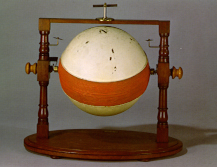
39 x 25.8 x 41
Wood, brass and copper
CAT. 1851 : 25.O.III
Um apparelho de Barlow, para illustrar theoria do magnetismo terrestre. Consta d'um globo de cartão envernizado, figurando a esphera terrestre. Este globo, movel á roda d'um eixo, é cingido no equador por uma serie de fios, de cobre isolados, pelos quaes se faz passar uma corrente voltaica, que imprime differente inclinação a uma agulha magnetica existente na parte superior, segundo a sua situação entre o equador e o polo. Outras duas agulhas magneticas situadas lateralmente, mostram a influencia das correntes electricas em roda do globo sob a direcção da agulha.
Apparatus by Barlow to illustrate theory of magnetism of the Earth. It comprises a globe of varnished card, representing the Earth. This globe, movable round an axis, has a belt of insulated copper wires around its equator, through which is passed a voltaic current, which imparts an inclination on a magnetic needle situated above, according to its position between the equator and the pole. Two more magnetic needles at the sides show the influence of the electric currents circling the globe on the direction of the needle.
This is a teaching instrument designed to illustrate Ampère's theory on the Earth's magnetism.
Oersted's discovery of the action of a current on a magnetic needle and Ampère's work during the following years, changed the way in which the Earth's action on compasses was regarded. Gilbert's theory that the Earth was a giant magnet began to look weak in the face of experimental data.
Experimental studies on electromagnetism eventually produced a model showing that terrestrial magnetism was based on circular electrical currents within the Earth.This theory emerged after Ampère had shown that magnetism always resulted from the presence of circular electrical currents inside a body. There was no reason to doubt that the Earth's magnetism had a different origin. A new field of research, termed geomagnetism, was thus opened. Since then, a great deal has been invested in perfecting models to explain the complexity of this magnetic field and its variations throughout Earth's history.
Barlow devised a teaching apparatus consisting of a wooden sphere around which he wound copper wires forming parallel coils at its equator. Small magnetic needles are arranged close to the sphere to simulate compass orientation when an electrical current is passed along the conducting wire encircling the sphere.
The Barlow sphere in the Gabinete de Física in Coimbra is mounted between two vertical wooden columns. It has three needles; two fixed at a latitude of around 45 º and a third, movable one, which can be placed, for instance, at the North or South poles of the sphere.